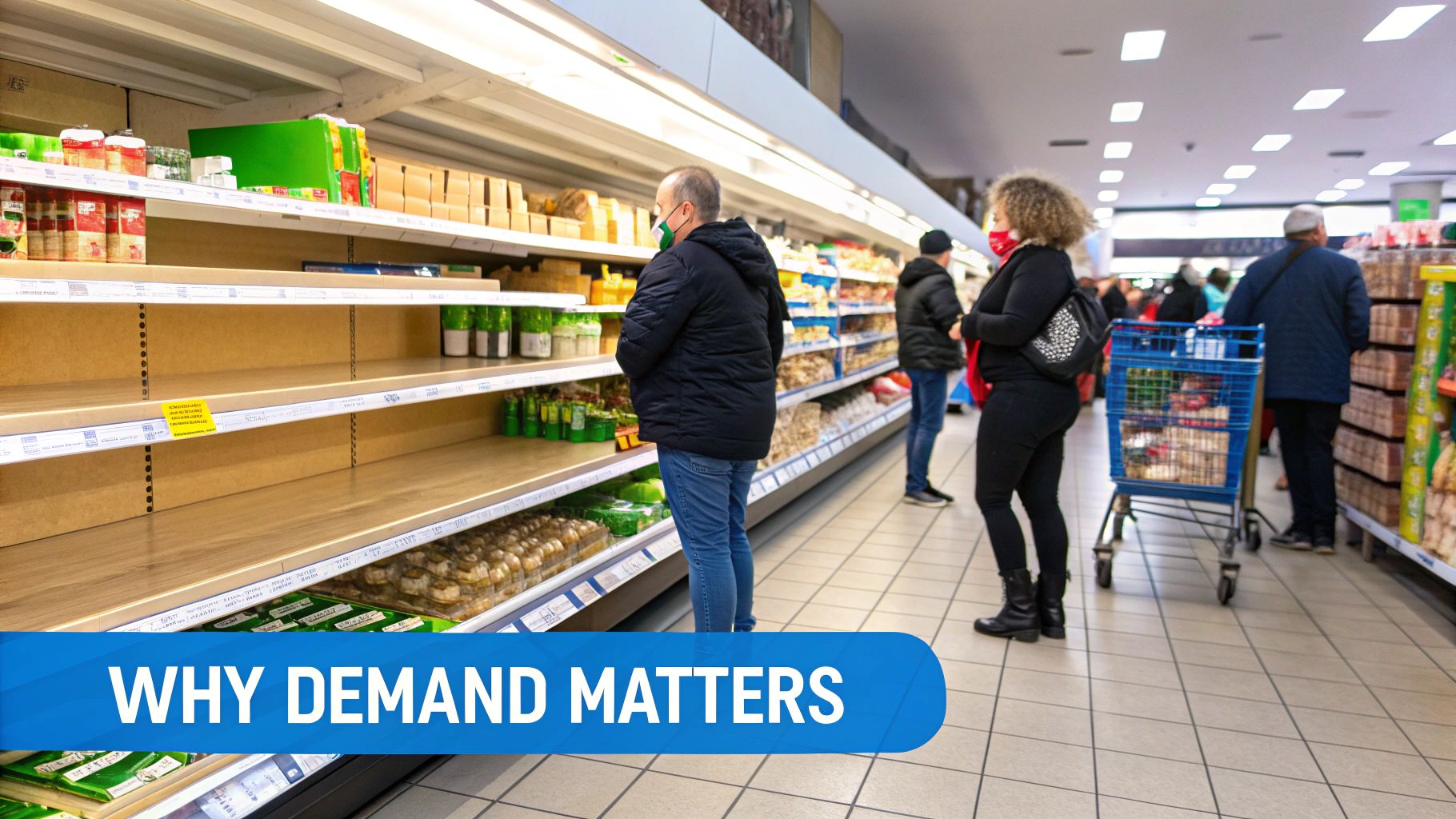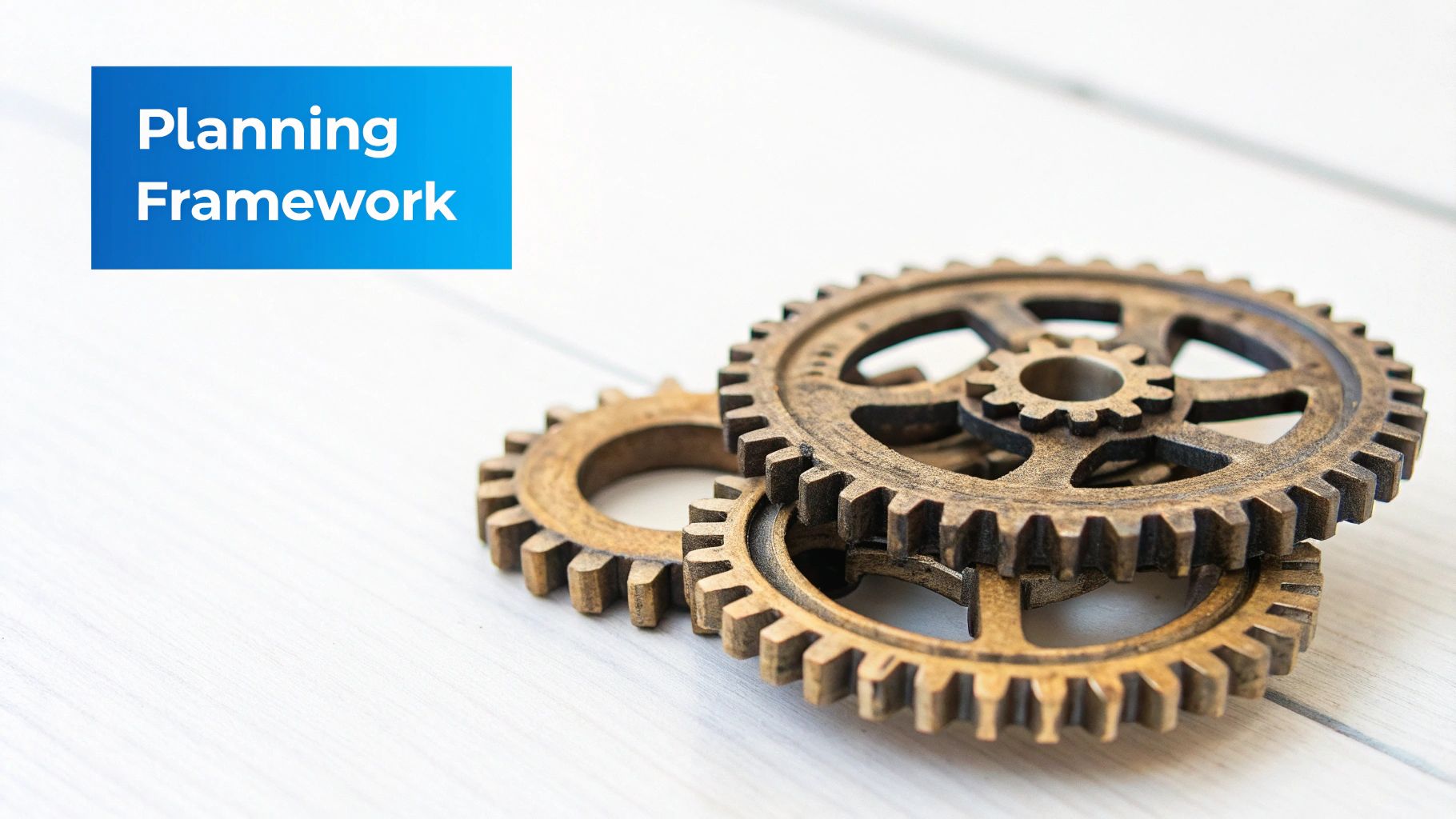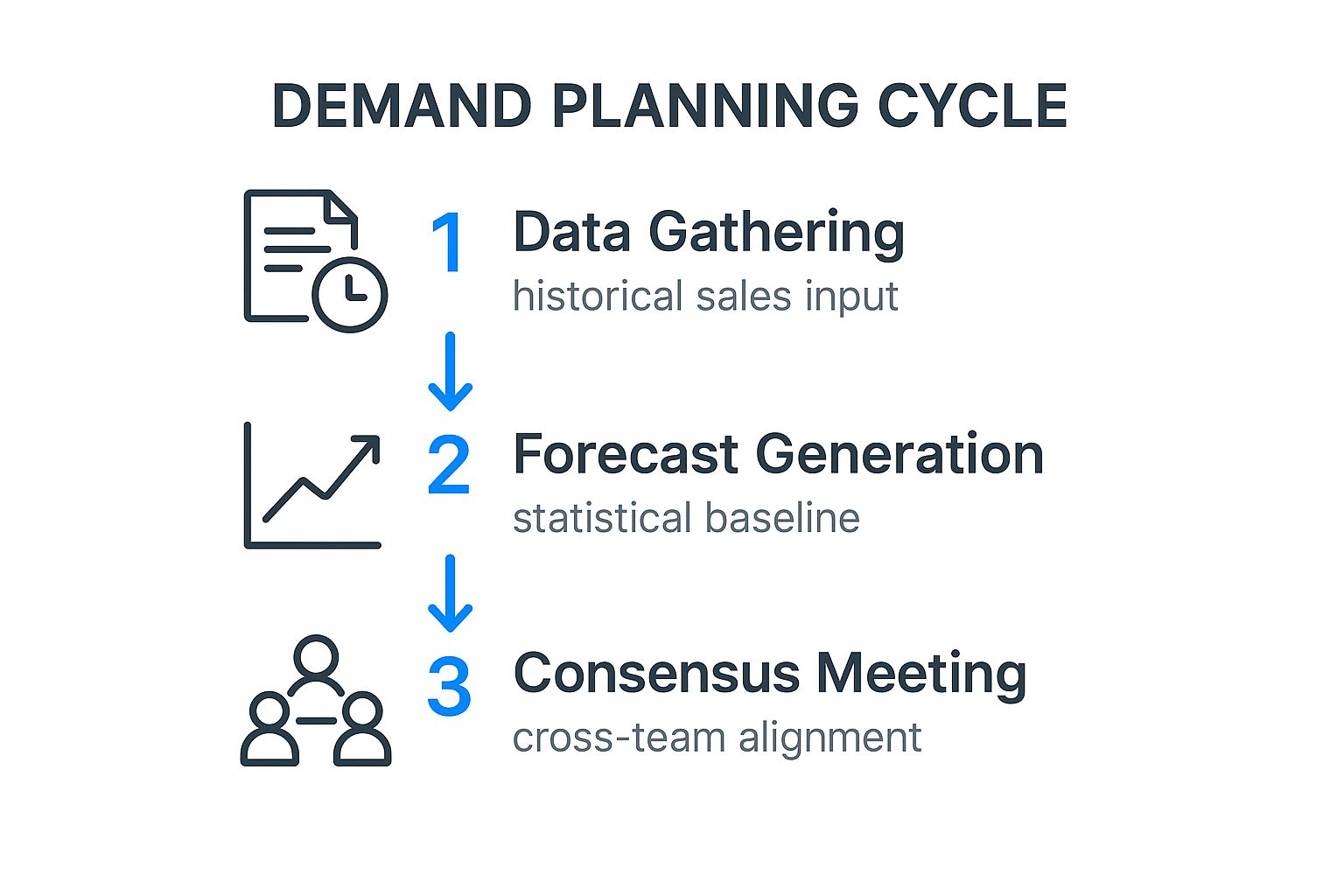So, what exactly is demand planning?
At its heart, demand planning is the process of looking into a crystal ball—backed by data, not magic—to predict what your customers will want to buy. It's all about making sure you have the right products, in the right place, at the right time. Nail this, and you avoid both the costly mistake of ordering too much and the frustrating experience of running out of stock.

Picture an e-commerce store gearing up for Black Friday. The smart ones don't just place a huge inventory order based on a gut feeling. No, they're digging into last year's sales data, looking at their marketing calendar, and even keeping an eye on what competitors are up to. That's demand planning in action.
It’s the connective tissue that links every part of your business. Your supply chain, inventory, marketing, and finance teams all get on the same page. Without a solid plan, these departments end up working in silos, which is a recipe for inefficiency and wasted money.
A great demand plan creates a single, reliable forecast that the entire company can use to make smart decisions. It turns a mountain of raw data into a clear, actionable strategy that keeps customers happy and operations humming.
Good demand planning isn't just about running numbers through an algorithm. It's a full-fledged framework built on four interconnected pillars that work together to give you a complete picture. Getting these right is the first step to building a more resilient and profitable business.
Each pillar tackles a different piece of the puzzle, from historical number-crunching to what your sales team is hearing on the ground. When you bring them all together, you get a 360-degree view of what's happening now and what’s likely to happen next. This is especially true for demand planning in ecommerce, where you have to react quickly to online trends.
To build a robust strategy, you need to focus on these four foundational components. Think of them not as a checklist, but as parts of a continuous cycle that feed into one another.
By mastering these pillars, you move from simply reacting to sales data to proactively shaping your business's future. It's the difference between being caught off guard and being two steps ahead.

To really get what demand planning is all about, let’s ditch the textbook definitions and look at a real-world scenario.
Imagine two e-commerce stores, "GadgetGo" and "TechForward." Both sell the same hot new smart home device. Out of the blue, a massive tech blog features the product, and online searches explode overnight.
GadgetGo runs on pure guesswork. With no demand plan in place, they are completely blindsided. Their website gets hammered with orders, and they sell out in just a few hours. Soon, the product page is filled with "out of stock" messages, frustrated customers are leaving bad reviews, and the sales are flowing straight to their competitors. The team scrambles to place an emergency restock, paying a fortune for expedited shipping that completely demolishes their profit margins. By the time the new inventory finally shows up, the viral buzz has faded.
Now, let's look at TechForward. They have a solid demand planning system running in the background. Their software flags the sudden spike in web traffic and social media chatter as a major anomaly. The planning team huddles up, analyzes the trend, and adjusts their forecast on the fly.
They instantly shift inventory from their slower-moving channels to the online store, keeping the product in stock just long enough to ride the initial wave of demand. At the same time, their newly updated forecast triggers an optimized restock order with their supplier, neatly sidestepping any rush fees.
The difference between these two stories isn't subtle—it's everything. It perfectly illustrates why this process is so fundamental to success. TechForward didn't just sell more gadgets; they built a healthier, more resilient business.
Their win highlights the direct, concrete benefits of having a plan.
This story reveals a core truth of modern commerce. Strong demand planning isn't just about shuffling boxes in a warehouse; it's a strategic weapon. You can learn more by exploring the wider role of demand management in ecommerce strategies and solutions to see how it all fits together.
Demand planning is the bridge between market opportunity and operational reality. Without it, you're leaving sales, customer satisfaction, and profitability to chance—a risk few businesses can afford to take in a competitive environment.
Ultimately, it turns your supply chain from a reactive part of the business that just costs money into a proactive engine that drives growth and makes your company stronger.

To really get what demand planning is all about, we need to pop the hood and look at its core components. The best way to think about the framework is like a well-oiled engine, where every single part has a distinct but interconnected job. It’s a complete system designed to turn raw data into smart, forward-looking business decisions.
The whole process kicks off with a solid, data-driven foundation. From there, it gets layered with human intelligence and strategic business goals. Each piece builds on the last, creating a comprehensive picture of what your customers will want next.
Let's break down these essential moving parts.
Everything starts with statistical forecasting. This is where you use your historical sales data to create a baseline prediction of the future. It’s a lot like a meteorologist using past weather patterns to predict tomorrow's forecast. Algorithms comb through your sales history, looking for trends, seasonality, and other patterns to project what sales might look like down the road.
This initial forecast is your objective, mathematical starting point. While it can’t predict everything—like a surprise celebrity endorsement—it provides an unbiased foundation that keeps you from making decisions based purely on guesswork. If you want to go deeper on the technical side, you can explore the different types, examples, and methods of demand forecasting that businesses use.
This baseline is critical, but it's only one part of the story. After all, historical data has no idea you're about to launch a massive marketing campaign next month.
This is where collaborative input comes in. No algorithm knows your business better than your own team. This part of the process is all about gathering insights from the departments that have their finger on the pulse of the market.
These teams provide critical context that raw data just can't see.
By layering this human expertise on top of the statistical baseline, the demand plan becomes significantly more accurate and realistic. It bridges the gap between what the data says happened and what your business plans to make happen.
Finally, the framework connects your forecast to real-world action through inventory optimization. The goal here is simple: align your stock levels with the demand plan you just created. This means making sure you have enough product to meet expected sales without tying up a ton of cash in overstocked inventory.
This is where the rubber meets the road. It directly impacts your profitability by cutting down on holding costs and reducing the risk of stockouts, which can lead to a loss of up to 65% of potential sales. It’s the practical application of all that forecasting and collaboration.
And it's not a one-and-done deal. The whole framework is a continuous loop, driven by ongoing performance measurement to get more and more accurate over time.
Effective demand planning isn't a one-and-done task. It's a structured, repeatable cycle that turns a mountain of raw data into a smart, unified business strategy. Think of it as the playbook that gets every department—from marketing to the warehouse—on the same page.
Following a clear process is what separates guessing from forecasting. It creates a reliable system for anticipating what your customers will want before they even know they want it. Let’s walk through what that looks like.
It all starts with good information. The first step is all about data collection and cleansing, and you can't afford to rush it. This is where you pull historical sales data from every corner of your business: your Shopify store, your ERP system, Amazon, and any other channel you sell through.
But this isn't just about dumping numbers into a spreadsheet. The real work is in cleaning it up. You have to identify and correct for those weird anomalies that could throw off your entire forecast—things like a stockout that made sales look artificially low or a one-off flash sale that caused a massive, unrepeatable spike. A clean dataset is the bedrock of a trustworthy forecast.
Once you have clean data, you can move on to generating a baseline statistical forecast. Using your historical sales info, forecasting algorithms get to work identifying trends, seasonal patterns, and other cycles in your business. This creates an objective, data-driven starting point for future demand.
This infographic gives a great high-level view of how the core steps flow together, moving from raw data to a final, aligned plan.

As you can see, each step builds on the last. You're progressively refining the information to create a forecast that’s both accurate and realistic.
A statistical forecast is just a number; it lacks real-world business context. That's why the next step, the consensus meeting, is so critical. This is where you bring together key players from sales, marketing, finance, and operations to add the human element to the data.
This meeting is where the magic happens. Teams bring insights the algorithm could never see:
The whole point of the consensus meeting is to land on a single, agreed-upon demand plan. This unified forecast becomes the one number that drives everything else, from purchasing raw materials to managing warehouse inventory.
From there, you reconcile this consensus plan with what you can actually supply. After all, a plan to sell 10,000 units is useless if you can only make 5,000. Finally, you constantly monitor your performance by tracking metrics like forecast accuracy. This feedback loop is what makes the process smarter over time and is essential to successfully forecast inventory.
It's no surprise that more businesses are adopting these structured processes. The global market for demand planning software was valued at around USD 3.62 billion in 2022 and is projected to hit USD 8.681 billion by 2030. As data from Zion Market Research shows, this explosive growth highlights just how essential solid planning has become in today's economy.
Not long ago, demand planning lived inside massive, clunky spreadsheets. It was a manual, backward-looking chore. Today, that world is gone. We’ve moved far beyond those limitations, with sophisticated tools now powering the entire process, delivering a level of accuracy and efficiency that was once pure science fiction.
While dedicated software and integrated ERP modules are now the norm, the real game-changer is the rise of Artificial Intelligence (AI) and machine learning.
Think of these technologies as a super-powered analyst who never sleeps. They can sift through mountains of data—your sales history, competitor pricing, social media trends, even weather forecasts—and spot connections a human team would almost certainly miss. An AI model can, for instance, predict the sales lift from an upcoming influencer campaign or calculate how a rival's price drop will ripple through your demand.
This power to digest vast amounts of information, both internal and external, elevates planning from a simple reporting function to a truly forward-looking strategic weapon.
Bringing Artificial Intelligence and machine learning into the mix isn't just a small step up; it's a fundamental shift in how businesses predict what their customers want. These systems are designed to learn from new data continuously, meaning they get smarter and more precise with every sales cycle.
This is especially true for business models like dropshipping, where technology is the backbone of managing inventory you never physically touch. Efficient supply chains in this space absolutely depend on tools that can keep up. You can learn more about how dropshipping automation tools play a crucial role in this process.
The results speak for themselves. Studies have shown that companies using AI-driven forecasting can boost their accuracy by 14% to 27%. That improvement translates directly into smarter inventory buys. For businesses dealing with perishable goods, this can slash waste by as much as 27%.
By identifying subtle patterns in consumer behavior, market trends, and even weather forecasts, AI gives businesses a significant competitive edge, allowing them to adapt to market shifts with unprecedented speed.
Another huge leap forward has been the move to cloud-based planning platforms. These tools have busted demand planning out of its departmental silo, creating a shared, collaborative space that anyone can access from anywhere.
This level of connectivity makes sure that everyone—from the supply chain manager ordering stock to the marketing lead planning a promotion—is working off the exact same, up-to-the-minute data. The key benefits here are pretty clear:
Ultimately, technology transforms demand planning from a periodic, manual headache into a continuous, intelligent, and highly strategic part of the business. It’s what allows companies to finally get ahead of the curve and act, not just react.
As companies start to get serious about demand planning, a few practical questions almost always come up. Getting these sorted out early on helps smooth out the process and gets everyone on the same page.
One of the big ones is the difference between demand planning and forecasting. I like to think of it this way: forecasting is a single ingredient, while demand planning is the entire recipe.
Forecasting is the specific act of predicting future sales, usually with some statistical modeling. Demand planning is the much bigger, strategic process that takes that forecast and uses it to align everything else—inventory levels, production schedules, marketing spend, and financial targets. Forecasting tells you what might happen; demand planning decides what you’re going to do about it.
Another question I hear all the time is about how often the plan needs to be revisited. There's no magic number here. The right rhythm really depends on your industry and how fast your products move.
The goal is to find a cadence that keeps you responsive without bogging your team down in constant administrative work.
Ultimately, a demand plan should be a living, breathing guide—not a static document you create once and forget. It needs to be reviewed and tweaked regularly as new market intelligence comes in, ensuring it remains a reliable map for your business.
Ready to stop guessing and start planning with precision? The expert team at Simpl Fulfillment can manage your inventory and logistics, ensuring your products are always where they need to be. Learn more at Simpl Fulfillment.